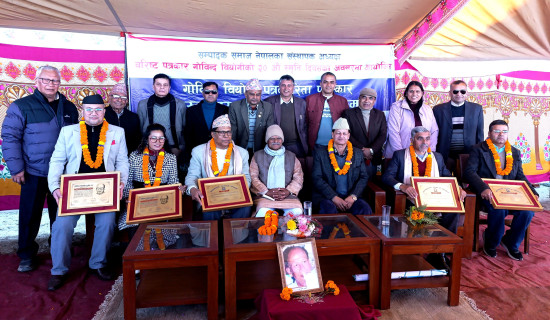- Sunday, 18 January 2026
Nepal confronts record-high temperatures and hostile climate change impacts
Kathmandu, June 11: In a record-breaking turn of events, Nepalis have endured the hottest summer in memory. According to data provided by the Department of Hydrology and Meteorology, this June marked the hottest month ever recorded in Nepal’s history.
The scorching heatwave not only affected the Terai and Hilly regions but even reached the capital city of Kathmandu, and eastern hill station Ilam experiencing unusually high temperatures. Both Kathmandu and Ilam are districts in the Hilly region of Nepal.
Nepal, like many other parts of the world, is grappling with the consequences of rising global temperatures. The changing climate patterns and escalating temperatures have led to a surge in extreme weather events such as erratic rains, heat waves, and alterations in the distribution of precipitation and snowfall across the country.
Known for its vast number of glaciers, Nepal is witnessing a rapid meltdown as temperatures continue to soar. The melting has contributed to the formation of glacial lakes, posing a significant risk to the adjacent regions. In recent years, glacial lakes are expanding at a considerable rate, as well as the risk of Glacial Lake Outburst Floods (GLOFs) like in the Bhote Koshi River in eastern Nepal on July 5, 2016, and in the Melamchi River in June 2021.
Dr. Indira Kandel, the head of the Meteorological Analysis Branch at the Department of Hydrology and Meteorology (DHM), said, “Nepal is experiencing a worrying trend of rising temperatures, and there are several factors to consider.
High solar radiation in the Chure region contributes to increased land surface heating, leading to higher air temperatures in the surrounding areas. The Chure acts as a source of heat, influencing the local climate and exacerbating temperature rise. Additionally, decreased pre-monsoon rainfall and climate change also contribute to hot days and warm nights.”
This year, Terai districts have recorded extreme heat waves, while hilly areas have also experienced higher maximum temperatures compared to previous years. Kandel further reveals that the intensification and frequency of global heatwaves have not spared South Asia, affecting the entire region.
She mentioned that the temperature conditions in the eastern Pacific Ocean, known as El Niño, play a crucial role. El Niño impacts wind speed and direction, resulting in increased occurrences of droughts in typically rainy areas and unexpected rains in typically arid regions.
The World Meteorological Organisation (WMO) also forecasts that global temperatures are expected to reach record levels in the next five years due to escalating greenhouse gas emissions and the influence of a natural El Niño event. According to a report released on May 17, 2023, there is a 66 per cent chance that temperatures likely to exceed a 1.5-degree Celsius compared to pre-industrial conditions between 2023 to 2027.
Impact on high Himalayas
A study published in Nature Reports reveals alarming findings regarding the South Col glacier on Mount Everest. This glacier, which took 2000 years to form, has vanished within the last three decades due to climate change. The research also suggests that Mount Everest’s South Col Glacier, an essential route for climbers, has lost approximately half of its mass since the 1990s and may disappear entirely by the middle of this century.
Dr. Rijan Bhakta Kayastha, a professor of glaciology at Kathmandu University, attributes the rise in temperatures to climate variability. The El Niño climate pattern has far-reaching consequences on global weather patterns, including temperature rise in specific regions, resulting in accelerated ice and snowmelt.
Kayastha emphasises that the impact extends beyond the iconic mountain itself, affecting the livelihoods and water resources of communities downstream. The loss of glaciers means reduced water availability in the long term, which will undoubtedly impact agriculture, hydropower generation, and the overall economy.
Impact on agriculture
The agricultural sector has not been spared from the consequences of rising temperatures. Dr. Hemu Kafle, a scientist at the Centre of Water and Atmospheric Research at the Kathmandu Institute of Applied Sciences, highlighted the severe impact of temperature rise on agriculture. Climate change has already affected various aspects, such as glacier melting, shifts in species ranges, and extreme precipitation events.
The increased frequency and intensity of extreme weather phenomena like droughts, floods, and heatwaves disrupt agricultural activities, jeopardizing crop growth, water availability, and overall productivity. Changes in temperature and precipitation patterns also lead to shifts in growing seasons, necessitating adjustments in planting and harvesting schedules. Nepal, in particular, is projected to experience higher warming than the global average, which can profoundly disrupt traditional agricultural practices.
Bibhuti Pokharel, chief of the Agro-met Section of the DHM, stated that they have already been engaged in discussions with officials from the National Agricultural Research Council (NARC) regarding the predicted drought conditions. They have requested the provision of drought-resistant crop varieties to farmers, especially those reliant on rainwater rather than irrigation systems.
Farmers are increasingly concerned about rising temperatures and the lack of rainfall, which negatively impact their livelihoods. The rising temperatures not only impact agriculture production but also pose risks to human health and biodiversity. Dr. Meghnath Dhimal, chief researcher at the Nepal Health Research Council (NHRC), highlighted that the temperature increase has significant implications for both human health and overall biodiversity. The changing climate can disrupt the delicate balance of flora and fauna, potentially leading to increased disease transmission.
According to Dhimal, one of the primary consequences of climate change is the proliferation of heat waves worldwide. These extreme weather events have a direct impact on public health, as they contribute to the rise in diseases and exacerbate the suffering of individuals with pre-existing health conditions. The raised room temperatures resulting from heat waves pose a potential risk to certain medications, which may become toxic when exposed to higher temperatures and thus require specific storage conditions.
These extreme events present significant challenges to Nepal’s development, food security, water resources, and overall resilience, Kandel, the head of the DHM’s Meteorological Analysis Branch, added. As the impacts of climate change continue to unfold, it is crucial for nations to collaborate on a global scale to reduce greenhouse gas emissions, strengthen climate resilience, and safeguard the future of our planet.
Positive aspects of climate change
While the global impacts of climate change tend to be predominantly negative, there are a few specific contexts where positive aspects or opportunities arise. Dr. Maan Bahadur Rokaya from the Institute of Botany at the Czech Academy of Sciences, currently in Kathmandu, pointed out that climate change has allowed farmers in the high Himalayan regions to cultivate crops that were previously unsuitable for those areas. Cultivation of crops such as millet, maize, cucumber and tomato has become possible at altitudes above 3000 metres. This shift has ensured local communities with self-sufficiency in agricultural production.
Rokaya emphasised the importance of highlighting such positive examples alongside the negative impacts, as they demonstrate the resilience and adaptive capacity of local people. He further explained that agriculture, once confined to lower elevations due to the tropical climate, is now thriving at higher altitudes, benefiting those residing in those regions.
















